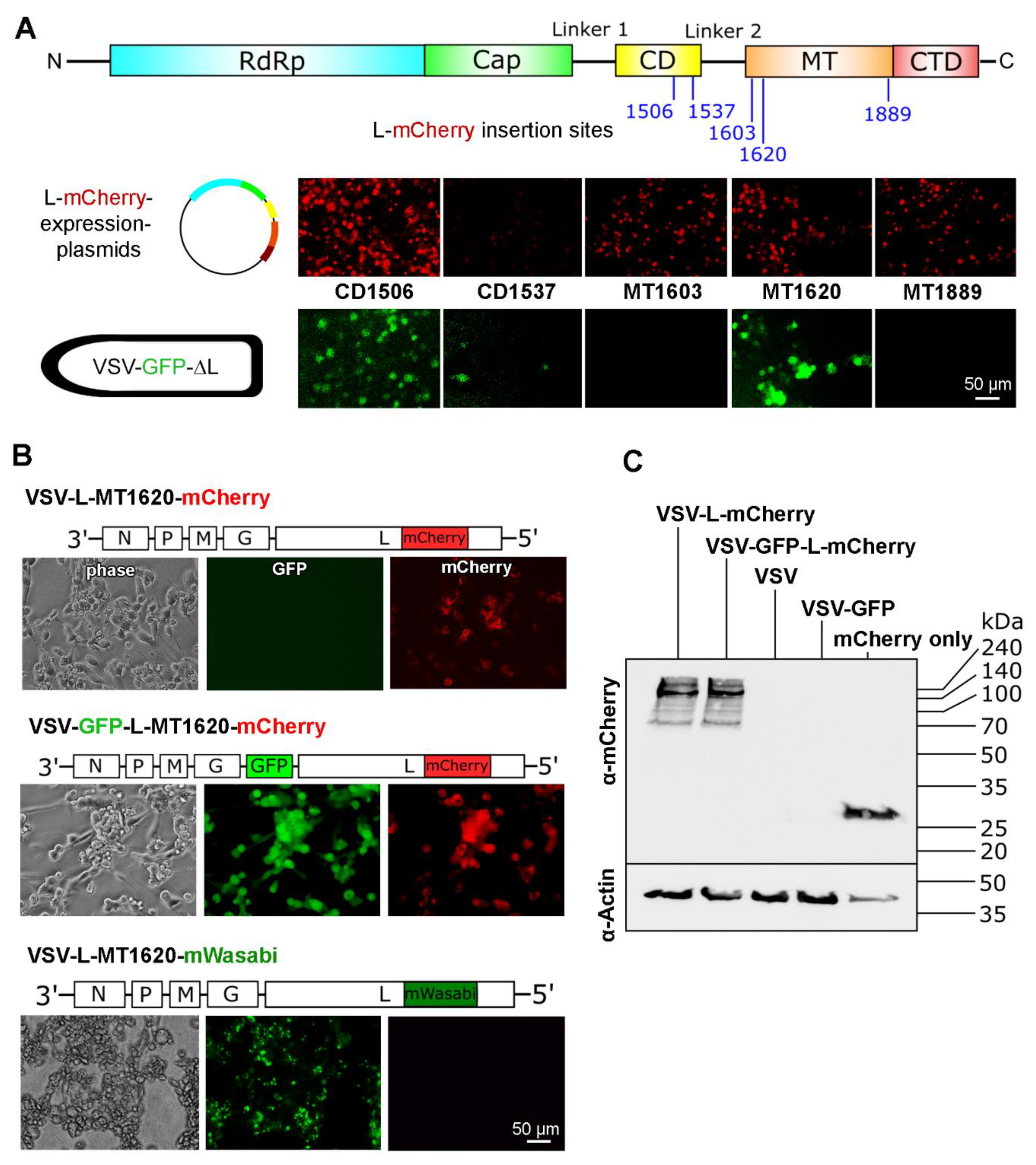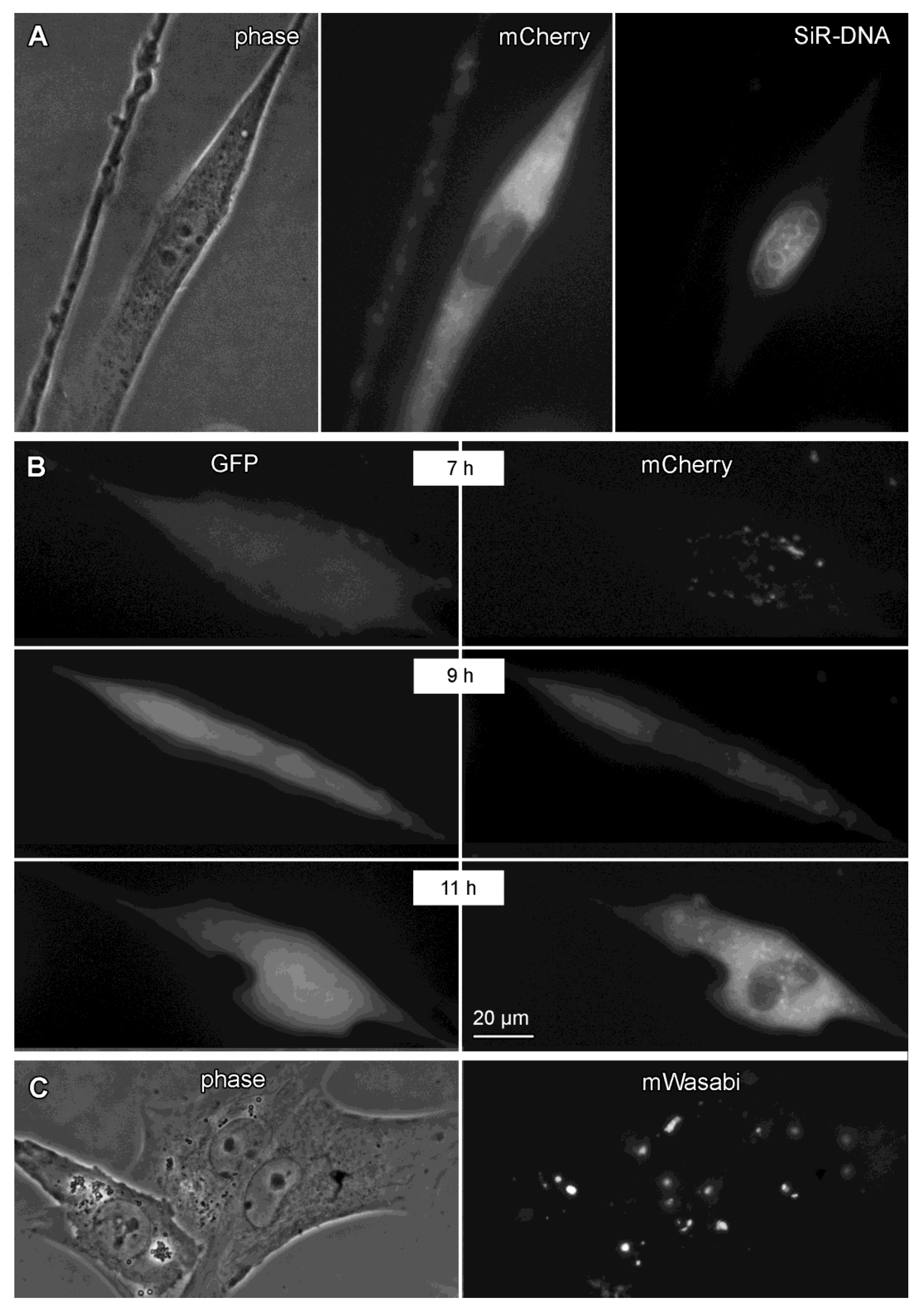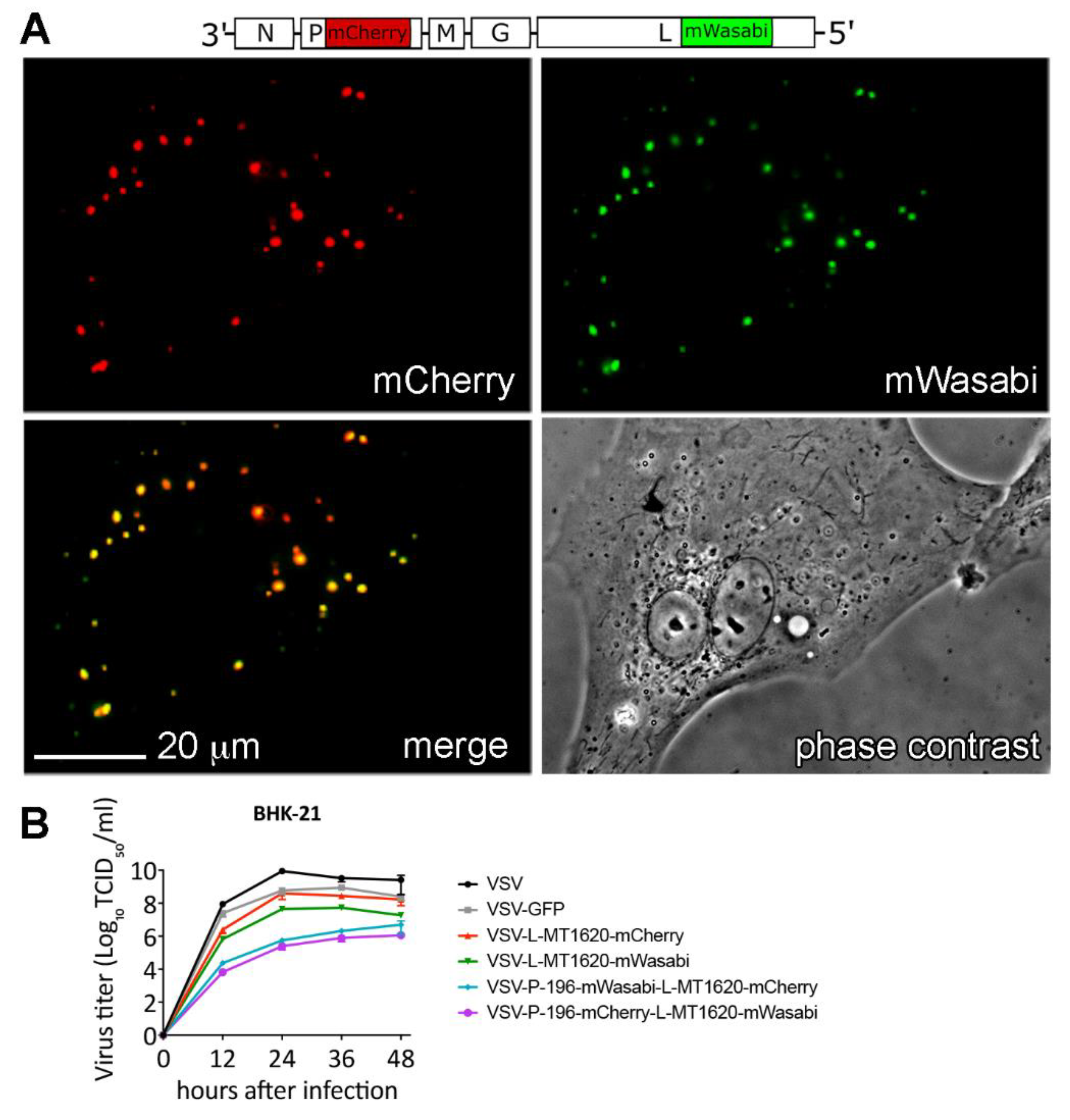The Methyltransferase Region of Vesicular Stomatitis Virus L Polymerase Is a Target Site for Functional Intramolecular Insertion
Abstract
:1. Introduction
2. Materials and Methods
2.1. Structure Visualization and Molecular Modeling
2.2. Viruses and Cells
2.3. Plasmid Construction
2.4. Mini-Genome Assay
2.5. Virus Recovery
2.6. Immunoblotting
2.7. Virus Sequencing
2.8. Plaque Assay
2.9. Single Step Growth Curve and TCID50 Assay
2.10. Interferon (IFN) Sensitivity and Cell Viability Assay
2.11. Virus Passage
2.12. Fluorescence Microscopy and Time-Lapse Recordings
3. Results
3.1. In Silico Prediction of Potential mCherry Insertion Sites
3.2. VSV-GFP-∆L Screening Points towards Two Promising Insertion Sites
3.3. MT1620 Insertion is Compatible with VSV Replication
3.4. Viral Genome Sequencing Reveals Secondary Mutations
3.5. Insertion of mCherry at Position MT1620 Results in Temperature-Stable VSV Recombinant with Mildly Attenuated Virus Replication and Activity
3.6. VSV L-MT1620-mCherry Insert Variants Are Genetically Stable
3.7. High Magnification Fluorescence Microscopy Shows Viral Inclusion Bodies and Distinct Patterns of Localization of GFP, L-mCherry, and L-mWasabi
3.8. A Dual Insertion VSV-P-mCherry-L-mWasabi Construct Displays Co-Localization of Fluorescently Tagged P and L Protein
4. Discussion
5. Patents
Supplementary Materials
Author Contributions
Funding
Acknowledgments
Conflicts of Interest
References
- Pringle, C.R.; Easton, A.J. Monopartite negative strand RNA genomes. Semin. Virol. 1997, 8, 49–57. [Google Scholar] [CrossRef]
- Abraham, G.; Banerjee, A.K. Sequential transcription of the genes of vesicular stomatitis virus. Proc. Natl. Acad. Sci. USA 1976, 73, 504–1508. [Google Scholar] [CrossRef] [PubMed]
- Ball, L.A.; White, C.N. Order of transcription of genes of vesicular stomatitis virus. Proc. Natl. Acad. Sci. USA 1976, 73, 442–446. [Google Scholar] [CrossRef] [PubMed]
- Ogino, T.; Banerjee, A.K. Unconventional mechanism of mRNA capping by the RNA-dependent RNA polymerase of vesicular stomatitis virus. Mol. Cell 2007, 25, 85–97. [Google Scholar] [CrossRef]
- Liang, B.; Li, Z.; Jenni, S.; Rahmeh, A.A.; Morin, B.M.; Grant, T.; Grigorieff, N.; Harrison, S.C.; Whelan, S.P.J. Structure of the l protein of vesicular stomatitis virus from electron cryomicroscopy. Cell 2015, 162, 314–327. [Google Scholar] [CrossRef]
- Qanungo, K.R.; Shaji, D.; Mathur, M.; Banerjee, A.K. Two RNA polymerase complexes from vesicular stomatitis virus-infected cells that carry out transcription and replication of genome RNA. Proc. Natl. Acad. Sci. USA 2004, 101, 5952–5957. [Google Scholar] [CrossRef] [Green Version]
- Das, S.C.; Nayak, D.; Zhou, Y.; Pattnaik, A.K. Visualization of intracellular transport of vesicular stomatitis virus nucleocapsids in living cells. J. Virol. 2006, 80, 6368–6377. [Google Scholar] [CrossRef]
- Soh, T.K.; Whelan, S.P.J. Correction for soh and whelan, tracking the fate of genetically distinct vesicular stomatitis virus matrix proteins highlights the role for late domains in assembly. J. Virol. 2016, 90, 5847. [Google Scholar] [CrossRef]
- Dalton, K.P.; Rose, J.K. Vesicular stomatitis virus glycoprotein containing the entire green fluorescent protein on its cytoplasmic domain is incorporated efficiently into virus particles. Virology 2001, 279, 414–421. [Google Scholar] [CrossRef]
- Ruedas, J.B.; Perrault, J. Putative domain-domain interactions in the vesicular stomatitis virus L polymerase protein appendage region. J. Virol. 2014, 88, 14458–14466. [Google Scholar] [CrossRef]
- Ruedas, J.B.; Perrault, J. Insertion of enhanced green fluorescent protein in a hinge region of vesicular stomatitis virus L polymerase protein creates a temperature-sensitive virus that displays no virion-associated polymerase activity in vitro. J. Virol. 2009, 83, 12241–12252. [Google Scholar] [CrossRef] [PubMed]
- Emsley, P.; Lohkamp, B.; Scott, W.G.; Cowtan, K. Features and development of Coot. Acta Crystallogr. D Biol. Crystallogr. 2010, 66, 486–501. [Google Scholar] [CrossRef] [PubMed]
- Pettersen, E.F.; Goddard, T.D.; Huang, C.C.; Couch, G.S.; Greenblatt, D.M.; Meng, E.C.; Ferrin, T.E. UCSF Chimera-a visualization system for exploratory research and analysis. J. Comput. Chem. 2004, 25, 1605–1612. [Google Scholar] [CrossRef] [PubMed]
- Pierce, B.G.; Wiehe, K.; Hwang, H.; Kim, B.H.; Vreven, T.; Weng, Z. ZDOCK server: Interactive docking prediction of protein-protein complexes and symmetric multimers. Bioinformatics 2014, 30, 1771–1773. [Google Scholar] [CrossRef]
- Mashiach, E.; Nussinov, R.; Wolfson, H.J. FiberDock: Flexible induced-fit backbone refinement in molecular docking. Proteins 2010, 78, 1503–1519. [Google Scholar]
- Pieper, U.; Webb, B.M.; Dong, G.Q.; Schneidman-Duhovny, D.; Fan, H.; Kim, S.J.; Khuri, N.; Spill, Y.G.; Weinkam, P.; Hammel, M.; et al. ModBase, a database of annotated comparative protein structure models and associated resources. Nucleic Acids Res. 2014, 42, D336–D346. [Google Scholar] [CrossRef]
- Boritz, E.; Gerlach, J.; Johnson, J.E.; Rose, J.K. Replication-competent rhabdoviruses with human immunodeficiency virus type 1 coats and green fluorescent protein: Entry by a pH-independent pathway. J. Virol. 1999, 73, 6937–6945. [Google Scholar]
- Schnell, M.J.; Buonocore, L.; Whitt, M.A.; Rose, J.K. The minimal conserved transcription stop-start signal promotes stable expression of a foreign gene in vesicular stomatitis virus. J. Virol. 1996, 70, 2318–2323. [Google Scholar] [Green Version]
- Muik, A.; Dold, C.; Geiss, Y.; Volk, A.; Werbizki, M.; Dietrich, U.; von Laer, D. Semireplication-competent vesicular stomatitis virus as a novel platform for oncolytic virotherapy. J. Mol. Med. Berl. 2012, 90, 959–970. [Google Scholar] [CrossRef] [Green Version]
- Panda, D.; Dinh, P.X.; Beura, L.K.; Pattnaik, A.K. Induction of interferon and interferon signaling pathways by replication of defective interfering particle RNA in cells constitutively expressing vesicular stomatitis virus replication proteins. J. Virol. 2010, 84, 4826–4831. [Google Scholar] [CrossRef]
- Gibson, D.G.; Young, L.; Chuang, R.Y.; Venter, J.C.; Hutchison, C.A., 3rd; Smith, H.O. Enzymatic assembly of DNA molecules up to several hundred kilobases. Nat. Methods 2009, 6, 343–345. [Google Scholar] [CrossRef] [PubMed]
- Witko, S.E.; Kotash, C.S.; Nowak, R.M.; Johnson, J.E.; Boutilier, L.A.; Melville, K.J.; Heron, S.G.; Clarke, D.K.; Abramovitz, A.S.; Hendry, R.M.; et al. An efficient helper-virus-free method for rescue of recombinant paramyxoviruses and rhadoviruses from a cell line suitable for vaccine development. J. Virol. Methods 2006, 135, 91–101. [Google Scholar] [CrossRef] [PubMed]
- Dold, C.; Rodriguez Urbiola, C.; Wollmann, G.; Egerer, L.; Muik, A.; Bellmann, L.; Fiegl, H.; Marth, C.; Kimpel, J.; von Laer, D. Application of interferon modulators to overcome partial resistance of human ovarian cancers to VSV-GP oncolytic viral therapy. Mol. Ther. Oncolytics 2016, 3, 16021. [Google Scholar] [CrossRef] [PubMed]
- Kärber, G. Beitrag zur kollektiven Behandlung pharmakologischer Reihenversuche. Naunyn Schmiedebergs Arch. Exp. Pathol. Pharmakol. 1931, 162, 480–483. [Google Scholar] [CrossRef]
- Rahmeh, A.A.; Schenk, A.D.; Danek, E.I.; Kranzusch, P.J.; Liang, B.; Walz, T.; Whelan, S.P. Molecular architecture of the vesicular stomatitis virus RNA polymerase. Proc. Natl. Acad. Sci. USA 2010, 107, 20075–20080. [Google Scholar] [CrossRef] [Green Version]
- Lee, S.; Lim, W.A.; Thorn, K.S. Improved blue, green, and red fluorescent protein tagging vectors for S. cerevisiae. PLoS ONE 2013, 8, e67902. [Google Scholar] [CrossRef]
- Heinrich, B.S.; Cureton, D.K.; Rahmeh, A.A.; Whelan, S.P. Protein expression redirects vesicular stomatitis virus RNA synthesis to cytoplasmic inclusions. PLoS Pathog. 2010, 6, e1000958. [Google Scholar] [CrossRef]
- Wertz, G.W.; Moudy, R.; Ball, L.A. Adding genes to the RNA genome of vesicular stomatitis virus: Positional effects on stability of expression. J. Virol. 2002, 76, 7642–7650. [Google Scholar] [CrossRef]
- Duprex, W.P.; Collins, F.M.; Rima, B.K. Modulating the function of the measles virus RNA-dependent RNA polymerase by insertion of green fluorescent protein into the open reading frame. J. Virol. 2002, 76, 7322–7328. [Google Scholar] [CrossRef]
- Brown, D.D.; Rima, B.K.; Allen, I.V.; Baron, M.D.; Banyard, A.C.; Barrett, T.; Duprex, W.P. Rational attenuation of a morbillivirus by modulating the activity of the RNA-dependent RNA polymerase. J. Virol. 2005, 79, 14330–14338. [Google Scholar] [CrossRef]
- Silin, D.; Lyubomska, O.; Ludlow, M.; Duprex, W.P.; Rima, B.K. Development of a challenge-protective vaccine concept by modification of the viral RNA-dependent RNA polymerase of canine distemper virus. J. Virol. 2007, 81, 13649–13658. [Google Scholar] [CrossRef] [PubMed]
- Deller, M.C.; Kong, L.; Rupp, B. Protein stability: A crystallographer’s perspective. Acta Crystallogr. F Struct. Biol. Commun. 2016, 72, 72–95. [Google Scholar] [CrossRef] [PubMed]
- Heinrich, B.S.; Maliga, Z.; Stein, D.A.; Hyman, A.A.; Whelan, S.P.J. Phase transitions drive the formation of vesicular stomatitis virus replication compartments. MBio 2018, 9, e02290-17. [Google Scholar] [CrossRef] [PubMed]
- Horikami, S.M.; De Ferra, F.; Moyer, S.A. Characterization of the infections of permissive and nonpermissive cells by host range mutants of vesicular stomatitis virus defective in RNA methylation. Virology 1984, 138, 1–15. [Google Scholar] [CrossRef]
- Lahaye, X.; Vidy, A.; Pomier, C.; Obiang, L.; Harper, F.; Gaudin, Y.; Blondel, D. Functional characterization of Negri bodies (NBs) in rabies virus-infected cells: Evidence that NBs are sites of viral transcription and replication. J. Virol. 2009, 83, 7948–7958. [Google Scholar] [CrossRef] [PubMed]
- Whelan, S.P.; Barr, J.N.; Wertz, G.W. Transcription and replication of nonsegmented negative-strand RNA viruses. Curr. Top. Microbiol. Immunol. 2004, 283, 61–119. [Google Scholar] [PubMed]
- Heppert, J.K.; Dickinson, D.J.; Pani, A.M.; Higgins, C.D.; Steward, A.; Ahringer, J.; Kuhn, J.R.; Goldstein, B. Comparative assessment of fluorescent proteins for in vivo imaging in an animal model system. Mol. Biol. Cell 2016, 27, 3385–3394. [Google Scholar] [CrossRef]
- Steinhauer, D.A.; Domingo, E.; Holland, J.J. Lack of evidence for proofreading mechanisms associated with an RNA virus polymerase. Gene 1992, 122, 281–288. [Google Scholar] [CrossRef]
- Drake, J.W.; Holland, J.J. Mutation rates among RNA viruses. Proc. Natl. Acad. Sci. USA 1999, 96, 13910–13913. [Google Scholar] [CrossRef] [Green Version]
- Li, W.; Gumpper, R.H.; Uddin, Y.; Schmidt-Krey, I.; Luo, M. Complementary mutations in the N and L proteins for restoration of viral RNA synthesis. J. Virol. 2018, 92, e01417-18. [Google Scholar] [CrossRef]
- Davis, J.N.; van den Pol, A.N. Viral mutagenesis as a means for generating novel proteins. J. Virol. 2010, 84, 1625–1630. [Google Scholar] [CrossRef] [PubMed]






| Name | For/Rev | Sequence (5′-3′ Direction) |
|---|---|---|
| CD1506insertGGSG for | for | GGCTCAGGCGGTGGATCCGGCCTGTGGCTGTTCAGCGACG |
| CD1506insertGGSG rev | rev | GCTCCCTCCGCCGCTTCCGCCCTGGCTGTAGTGGCTGCGG |
| CD1537insertGGSG for | for | GGCTCAGGCGGTGGATCCGGCAGCGGCAAGGACAAGAACGAG |
| CD1537insertGGSG rev | rev | GCTCCCTCCGCCGCTTCCGCCCAGGAAGGGCTTGTACAGGATC |
| MT1603insertGGSG for | for | GGCTCAGGCGGTGGATCCGGCGAGAGCCGCGGCACCATCAC |
| MT1603insertGGSG rev | rev | GCTCCCTCCGCCGCTTCCGCCGCGGCCCCAGGGAGGGTAG |
| MT1620insertGGSG for | for | GGCTCAGGCGGTGGATCCGGCTACCCCAAGATGCTGGAGATGC |
| MT1620insertGGSG rev | rev | GCTCCCTCCGCCGCTTCCGCCTGGGGTGGTGGTGTAGTACAC |
| MT1889insertGGSG for | for | GGCTCAGGCGGTGGATCCGGCCAGTTCATCCCCGACCCCTTC |
| MT1889insertGGSG rev | rev | GCTCCCTCCGCCGCTTCCGCCGCTGGGGATGCCGGTCAGG |
| mCherry-GGSG for | for | GGCGGAAGCGGCGGAGGGAGCGGGGGCGGGAGCGGAATGGTGAGCAAGGGCGAGG |
| mCherry-GGSG rev | rev | GCCGGATCCACCGCCTGAGCCGCCTCCGGACCCTCCCTTGTACAGCTCGTCCATG |
| Gibson new for | for | GGCAGGGTCGGAACAGGAG |
| Gibson new rev | rev | CAGGCGTTTCCCCCTGGAAG |
| Name | For/Rev | Sequence (5′-3′ Direction) |
|---|---|---|
| CD1506insertGGSG rev | for | GGCTCAGGCGGTGGATCCGGCCAATTATGGTTATTCTCAG |
| CD1506insertGGSG for | rev | GCTCCCTCCGCCGCTTCCGCCTGAATAATGTGATCTGTATTTTC |
| MT1620insertGGSG rev | for | GGCTCAGGCGGTGGATCCGGCTACCCAAAGATGCTAGAGATG |
| MT1620insertGGSG for | rev | GCTCCCTCCGCCGCTTCCGCCAGGGGTGGTCGTATAATAAAC |
| mCherry-GGSG for | for | GGCGGAAGCGGCGGAGGGAGCGGGGGCGGGAGCGGAATGGTGAGCAAGGGCGAGG |
| mCherry-GGSG rev | rev | GCCGGATCCACCGCCTGAGCCGCCTCCGGACCCTCCCTTGTACAGCTCGTCCATG |
| 49bp-before-FseI | for | GCTGCCAAGTAATACACCGG |
| 50bp-after-SfoI | rev | TTTATCTCCTCCTAAAGTTTC |
| 196-GGSG-P for | for | GGCTCAGGCGGTGGATCCGGCGTTTGGTCTCTCTCAAAGACAT |
| 196-GGSG-P rev | rev | GCTCCCTCCGCCGCTTCCGCCATCTGATACTGCTTCTGATTGG |
| 33bp-before-Bst1107l | for | AAGGAATGCCCGACAGCC |
| 35bp-after-XbaI | rev | TCCGTCACCTCCGACAGAG |
| CD1595insertGFP for | for | GGCATGGACGAGCTGTACAAGATGAGCTATCCCCCTTGGGG |
| CD1595insertGFP rev | rev | CAGTTCCTCGCCCTTGCTCATGTCTTTATTATTATCCTTAGCAATCCCG |
| GFP for | for | ATGAGCAAGGGCGAGGAACT |
| GFP rev | rev | CTTGTACAGCTCGTCCATGCC |
© 2019 by the authors. Licensee MDPI, Basel, Switzerland. This article is an open access article distributed under the terms and conditions of the Creative Commons Attribution (CC BY) license (http://creativecommons.org/licenses/by/4.0/).
Share and Cite
Heilmann, E.; Kimpel, J.; Geley, S.; Naschberger, A.; Urbiola, C.; Nolden, T.; von Laer, D.; Wollmann, G. The Methyltransferase Region of Vesicular Stomatitis Virus L Polymerase Is a Target Site for Functional Intramolecular Insertion. Viruses 2019, 11, 989. https://doi.org/10.3390/v11110989
Heilmann E, Kimpel J, Geley S, Naschberger A, Urbiola C, Nolden T, von Laer D, Wollmann G. The Methyltransferase Region of Vesicular Stomatitis Virus L Polymerase Is a Target Site for Functional Intramolecular Insertion. Viruses. 2019; 11(11):989. https://doi.org/10.3390/v11110989
Chicago/Turabian StyleHeilmann, Emmanuel, Janine Kimpel, Stephan Geley, Andreas Naschberger, Carles Urbiola, Tobias Nolden, Dorotheé von Laer, and Guido Wollmann. 2019. "The Methyltransferase Region of Vesicular Stomatitis Virus L Polymerase Is a Target Site for Functional Intramolecular Insertion" Viruses 11, no. 11: 989. https://doi.org/10.3390/v11110989
APA StyleHeilmann, E., Kimpel, J., Geley, S., Naschberger, A., Urbiola, C., Nolden, T., von Laer, D., & Wollmann, G. (2019). The Methyltransferase Region of Vesicular Stomatitis Virus L Polymerase Is a Target Site for Functional Intramolecular Insertion. Viruses, 11(11), 989. https://doi.org/10.3390/v11110989






